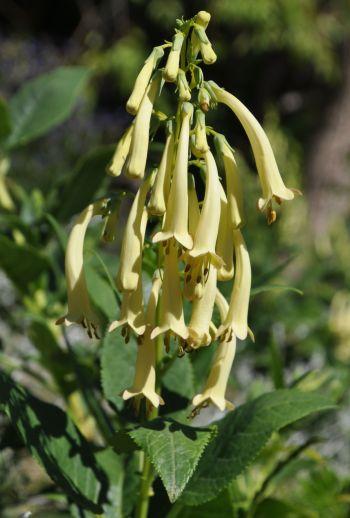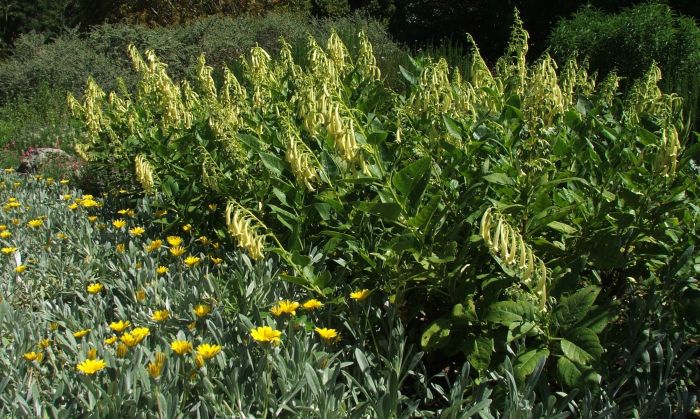Phygelius aequalis
Phygelius aequalis Harv. ex Hiern
Family: Scrophulariaceae
Common names: river bell, wild fuchsia (Eng.); foksia, rivierklokkie (Afr.); metsi-matso (Southern Sotho)
Introduction
A beautiful, lush, fast-growing, evergreen perennial, with spikes of showy trumpet-shaped, red or yellow flowers and a long blooming season.

Description
Description
Phygelius aequalis is a robust, herbaceous perennial that grows up to 1m tall. The leaves are simple and ovate with toothed margins. The pendent flowers are arranged in a compact spike. The flowers are salmon-orange with a tubular shape that opens into 5 pointed petals. The petals are outlined in deep red while the throat is yellow. The deep crimson stamens protrude, adding to the decoration of the flower. It flowers from early summer to autumn (November to May). After flowering, the fruit, an ovoid capsule, is formed. A yellow-flowered form called 'Yellow Trumpets' is available.

Conservation Status
Status
According to the Red List of South African Plants, Phygelius aequalis is assessed as Least Concern (LC).

Distribution and habitat
Distribution description
Phygelius aequalis occurs along rocky stream banks in open woodland and forests, at altitudes of 1200-2200 m in the Northern Province, Mpumalanga, Free State, KwaZulu-Natal, Lesotho and Swaziland, where it receives rain during summer.
Derivation of name and historical aspects
History
The name Phygelius is thought to be derived from the Greek word, phyge, meaning flight or refuge, and helios, meaning sun, hence refuge from sun, because the plants were said to love the shade. The Latin species name aequalis means similar in size or equal.
This genus has two species, Phygelius capensis and P. aequalis, the main difference being P. capensis has flowers evenly spaced around the stem, whereas P. aequalis has flowers hanging to one side. There are a few cultivars of these two species, mainly interspecific hybrids, which are commercially available. The cultivars are popular in the United Kingdom where most of the breeding has been done.
Ecology
Ecology
The bright red or yellow flowers of Phygelius attract pollinators such as bees, butterflies and birds, especially sunbirds.

Uses
Use
It is used in traditional medicine, and as a charm to prevent hail damage to crops.
Phygelius aequalis, P. capensis and their cultivars are growing in popularity in English gardens, due to their cold hardiness, their long flowering season and the bright intense colours which they display.
This is an eye-catching, ornamental plant. It goes well in mixed borders, where it can grow to 1 m tall but it also looks great in hanging baskets, and large pots. The best height for appreciating this plant is eye level, where the colourful throat of the drooping tubular flowers can be seen.
Growing Phygelius aequalis
Grow
This plant can be propagated by seed or by cuttings.
Once the seed capsules are brown, break them open and shake the seeds into a paper bag. Place the bag somewhere warm so that the the seeds can dry completely. Once the seeds have dried, move the bag to a cool dry place for storage. Sow the seeds in spring in a seed tray filled with a well-drained potting mix.
Phygelius aequalis can be propagated by stem or tip cuttings. Select healthy cutting material, taken in midsummer. With the use of a rooting hormone and bottom heating, the cuttings will root within three weeks. It is also possible to transplant the offset suckers from the parent plant.
This plant thrives near water. If situated far from water, it will need regular watering during the summer months. It needs a rich, well-drained, loamy soil with plenty of compost. It loves a warm semi-shade to sunny position in the garden. If grown in deep shade, it will become leggy. Prune in late winter to early spring to encourage bushy growth. Phygelius aequalis will add a luscious, colourful look to any garden.
References
- http://www.californiagardens.com/Plant_Pages/phygelius_capensis.htm
- http://florawww.eeb.uconn.edu/acc_num/199200976.html
- http://www.joycreek.com/215-002-1.htm
- http://www.alfresco-dining.info/garden/phygelius.html
- http://hort.ifas.ufl.edu/floriculture/Crops/Phygelius%20production%2004%20GPN.pdf
- Eliovson, S. 1955. South African wild flowers for the garden. Macmillan, Johannesburg ?.
- Fabian, A. & Germishuizen, G. 1997. Wild flowers of northern South Africa. Fernwood Press, Vlaeberg, Cape Town.
- Hilliard, O.M. & Burtt, B.L. 1987. The botany of the southern Natal Drakensberg. vol. 15. National Botanical Gardens, Cape Town
- Joffe, P. 2001. Creative gardening with indigenous plants. A South African g uide. Briza Publications, Pretoria.
- Pooley, E. 1998. A field guide to wild flowers of KwaZulu-Natal and the Eastern Region. Natal Flora Publications Trust, Durban.
Credits
Karen Wall
Kirstenbosch National Botanical Garden
July 2007
Plant Attributes:
Plant Type: Perennial
SA Distribution: Eastern Cape, Free State, KwaZulu-Natal, Limpopo, Mpumalanga
Soil type: Sandy, Loam
Flowering season: Late Summer
PH: Acid, Neutral
Flower colour: Red, Cream
Aspect: Full Sun, Morning Sun (Semi Shade), Afternoon Sun (Semi Shade)
Gardening skill: Average
Special Features:
Horticultural zones










Rate this article
Article well written and informative
Rate this plant
Is this an interesting plant?
Login to add your Comment
Back to topNot registered yet? Click here to register.